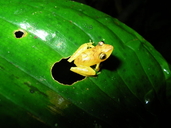
Sachatamia ilex is a species of frog in the family Centrolenidae. It is found in eastern Nicaragua, Costa Rica, Panama, western Colombia, and western Ecuador. Common name Limon giant glass frog has been coined for this species, apparently in reference to its type locality in the canton of Limón, Costa Rica, and it is also known as the ghost glass frog.

Cochranella euknemos, sometimes known as the San Jose Cochran frog, is a species of frog in the family Centrolenidae. It is found in central Costa Rica and south/eastward to Panama and to the western flank of the Cordillera Occidental in Colombia. Some Colombian records might apply to Cochranella mache.
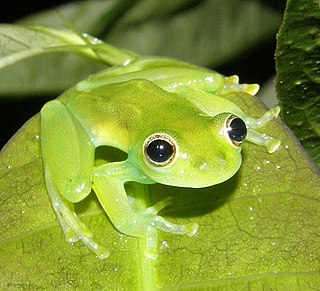
Teratohyla spinosa is a species of frog in the family Centrolenidae. It is found in the Pacific lowlands of northern and central Ecuador and western Colombia, northward on the Pacific slopes Panama and Costa Rica, as well as on the Caribbean slopes of Costa Rica, Nicaragua, and Honduras.
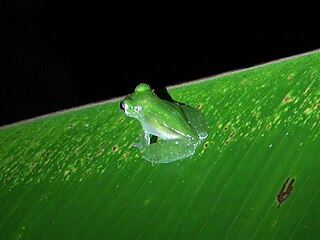
Hyalinobatrachium valerioi, sometimes known as the La Palma glass frog, is a species of frog in the family Centrolenidae. It is found in central Costa Rica and south to Panama and the Pacific lowlands and slopes of western Colombia and Ecuador; also in the Magdalena River Valley of Colombia.
Silverstoneia nubicola is a species of frog in the family Dendrobatidae. It is found in western Colombia, Panama, and southwestern Costa Rica.
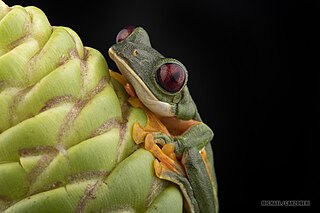
The gliding tree frog is a species of frog in the subfamily Phyllomedusinae. It is found in Colombia, Costa Rica, Ecuador, and Panama. Other common names are the gliding leaf frog, Spurrell's leaf frog, and pink-sided tree frog. The specific name, spurrelli, is in honour of British zoologist Herbert George Flaxman Spurrell.

Dendropsophus phlebodes, the San Carlos treefrog or San Carlos dwarf treefrog, is a species of frog in the family Hylidae. It is found in western Colombia, Costa Rica, Nicaragua and Panama. Its natural habitats are tropical moist lowland forests, but it may also occur in disturbed habitats. It is threatened by habitat loss.
Isthmohyla lancasteri is a species of frog in the family Hylidae. It is endemic to humid premontane slopes of the Cordillera de Talamanca in Costa Rica and western Panama.

Scinax elaeochroa, commonly known as the Sipurio snouted treefrog, or olive snouted treefrog, is a species of frog in the family Hylidae. It is found in the Caribbean lowlands of Nicaragua and Panama and in the Pacific lowlands of Costa Rica and Panama, with an isolated population in Colombia.

Strabomantis bufoniformis is a species of frog in the family Strabomantidae. It is found in western Colombia, Panama, and south-eastern Costa Rica. It is sometimes known as the rusty robber frog.
Craugastor obesus is a species of frog in the family Craugastoridae. It is found in the Caribbean slopes of southeastern Costa Rica and western Panama. Its natural habitats are lowland moist forest, premontane and lower montane wet forest and rainforest. It can be found in the spray zone on rocks, boulders, and cliff faces in the middle of moderate-sized cascading streams.
Craugastor talamancae is a species of frog in the family Craugastoridae. It is found in the Atlantic versant of Panama, Costa Rica, and southeastern Nicaragua. Common name Almirante robber frog has been proposed for it.
Pristimantis altae, also known as mountain robber frog, is a species of rain frog in the family Strabomantidae with a bright coral-coloured groin. It is found in Costa Rica and Panama.

Pristimantis cruentus is a species of frog in the family Strabomantidae, sometimes known as the Chiriqui robber frog. It is found in Costa Rica, Panama, and north-western Colombia. Its natural habitats are forests, including humid lowland and montane forests. It can also be found in degraded habitats outside forests. It is threatened by habitat loss.
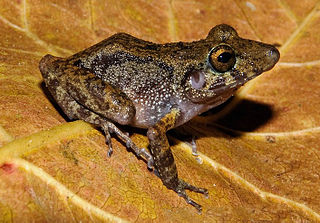
Pristimantis gaigei, also known as Fort Randolph robber frog or Gaige's rain frog, is a species of frog in the family Strabomantidae. It is found in the Atlantic drainage lowlands from extreme south-eastern Costa Rica to eastern Panama and to central Colombia; it is widely distributed in Colombia west of the Cordillera Oriental. Its natural habitat is primary humid lowland forest, but it also occurs in secondary forest. It is a nocturnal species found under surface debris and in leaf-litter.
Pristimantis moro, also known as La Hondura robber frog, is a species of frog in the family Strabomantidae. It is found in lowland western Colombia, the Pacific versant of Panama, and the Atlantic versant of Costa Rica.
Pristimantis pardalis is a species of frog in the family Strabomantidae. It is found in Costa Rica and Panama. Its natural habitats are tropical moist lowland forests and moist montane forests. It is threatened by habitat loss.
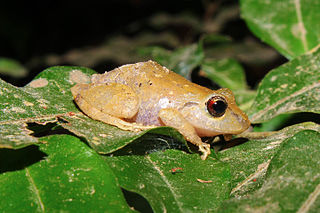
Pristimantis ridens, also known as the pygmy rain frog and the Rio San Juan robber frog, is a species of frog in the family Strabomantidae. It is found in western Colombia, and then through Panama and Costa Rica to Nicaragua and eastern Honduras.
Ctenophryne aterrima is a species of frog in the family Microhylidae. It is found in northwestern Ecuador, the Andes of Colombia, and lowland and premontane zones of Panama and Costa Rica to about 1,600 m (5,200 ft) above sea level.
Pristimantis educatoris is a species of frog in the family Strabomantidae. It is found in Costa Rica, Panama, and Colombia and is similar to—and prior to its description in 2010—confused with Pristimantis caryophyllaceus. The species was first found in 2002 while researchers were working on a way to save Panama's frogs from extinction from the deadly amphibian disease chytridiomycosis. The species was discovered in Omar Torrijos National Park in Coclé Province, Panama.
